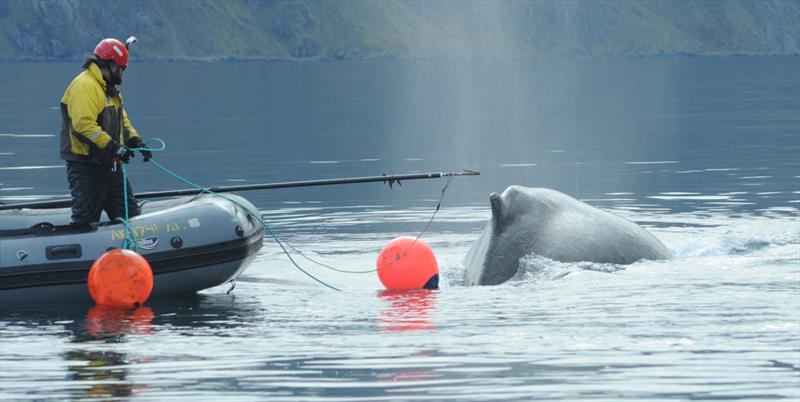
New online course for spotting and reporting entangled whales in Alaska Waters
by NOAA Fisheries 11 Oct 2019 05:49 UTC

NOAA Fisheries' John Moran reaches with a pole to cut a line entangling a humpback whale in Dutch Harbor, Alaska © NOAA Fisheries
Highly-trained responders depend on boating community to be "eyes and ears" on the water.
The foundation of responding to entangled whales is the on-water community. NOAA's Alaska Marine Mammal Stranding Network depends on recreational and commercial boaters and other ocean users for spotting and reporting entangled whales off Alaska's coast. That's one reason NOAA Fisheries has teamed up with The Nature Conservancy (TNC) to develop a new online training course to help them report entanglements.
Most often, fishermen, tour boat operators, and whale researchers are the ones to first report entanglements. The course will prepare them, and others, to report entanglements in Alaska.
Responding to whale entanglements can be dangerous. Only highly trained and experienced teams with the proper equipment should attempt to disentangle whales.
Boaters who come across entangled whales can still help in the response without getting too close. They can collect information and monitor the whale until trained teams arrive. By knowing what information to collect, and taking and sharing photos with the disentanglement team, boaters can help marine mammal responders. These teams have advanced training to understand the extent of the entanglement before mounting a response. This enables them to respond with the right gear.
"Fishermen and other boaters are our eyes on the water," said Jon Kurland, head of the NOAA Fisheries Alaska Region Protected Resources Division. "Countless times the information they have provided about a whale entanglement has been the key factor in our response network's ability to locate the animal, assess its condition, and attempt to disentangle it if the conditions are right."
"Commercial and recreational fishermen are an untapped resource who could provide a much broader and stronger foundation for entanglement response networks given the right training," said Tom Dempsey, Oceans Program Director at TNC. "It makes sense to develop a training course for them since they want to be a part of the solution, and they are often onsite when entanglements occur."
The online course is an introduction to the entanglement response program and underscores the different levels of expertise required and safety precautions. The module includes information on how to identify whale species, observe their behavior, and assess and document the entanglement through photographs and video. Much more extensive, in-person training is required to qualify for disentanglement teams that are part of the Large Whale Entanglement Response Network overseen by NOAA Fisheries.
TNC provided the computer platform and technical expertise to develop the online course. NOAA Fisheries, NOAA's Hawaiian Islands Humpback Whale National Marine Sanctuary, the Center for Coastal Studies, and other members of the response network provided course content. This includes information, interviews, photographs, and video of previous entanglements.
"This course really supports our overall vision for healthy, thriving ecosystems and stable, productive fisheries," added Dempsey. "We've already helped to develop region-specific online courses for whale entanglement response for the West Coast Region, and now the Alaska Region. The Pacific Islands Region course will be available soon to that on-water community. We are going forward to develop similar training for other regions of NOAA Fisheries as well."